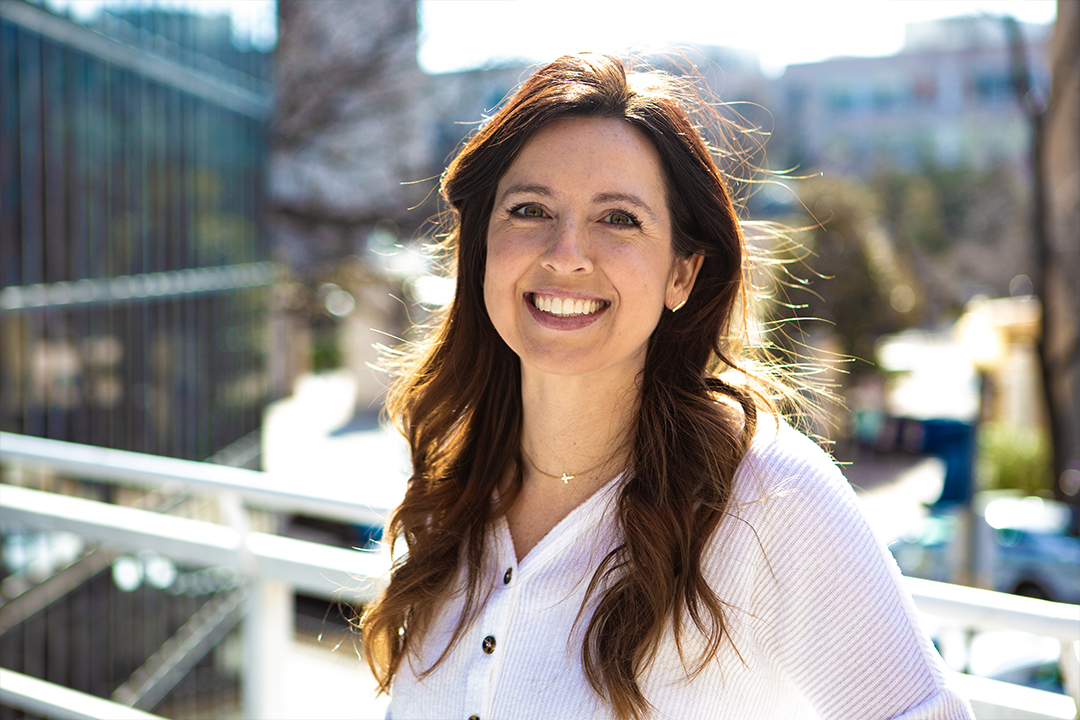Prior to embarking on her graduate studies in speech pathology at Columbian College, Sarah Hine worked with survivors of sex trafficking in India. Well before the COVID crisis curtailed international travel, Hine spent three years coordinating nonprofit efforts in the United States and India to help young girls who had escaped from brothels in Mumbai and Calcutta. She provided support to India-based organizations who guided the girls—mostly teens, some as young as 10—through the difficult process of psychological and physical healing.
As she befriended the young women, she observed that many struggled with communication. Some were essentially nonverbal, reluctant to engage with others and preferring to sit in a corner with their ear phones on. Others showed signs of cognitive deficits— seemingly slow to process conversation and refusing to make eye contact. None of those signs were by themselves surprising; reactions to chronic trauma manifest themselves in any number of ways. But Hine noticed a possible correlation between the extent of the abuse and the severity of their speech issues. “I started to realize that maybe there are some gradients depending on the type of trauma someone received or the length of exposure to a traumatic situation that might indicate impacts on language,” she said. But the available research on such links was small, and the guidelines for speech language pathologists often even smaller.
As a second-year graduate student, Hine has been helping to fill that gap. She is drawing from her personal experiences for a project in Associate Professor Adrienne Hancock’s research lab in the Department of Speech, Language and Hearing Sciences. Hine is one of a group of students investigating the intersection between language and complex psychosocial trauma. They are looking at how trauma in vulnerable people—from survivors of sex trafficking to children in the foster care system—can manifest itself in speech and language disorders.
Their research involves conducting literature reviews of past studies, examining clinical best practices and learning from other disciplines, such as social work, psychology and neuroscience. While some of their work has been put on hold during the coronavirus pandemic—for example, a planned panel discussion with trauma care experts from social work and the Columbian College Art Therapy Program has been postponed—the group continues to meet via email and videoconferencing to continue their research. “As best we can, we are going ahead as planned,” Hine said.
Turning Experience Into Practice
Trauma-informed care, Hancock said, is playing an increasingly large role in education and healthcare—settings where most speech-language pathologists work. But guidelines for how to recognize the link between psychosocial trauma and speech disorders—along with recommendations for how to respond to them—are still in their infancy. Hancock said her team hopes “to inform ourselves and our clinical practices” and develop a resource guide for speech-language pathologists.
Hine and three other graduate students—second-years Caitlin McDonnell and Isabelle Nejedlik, and first-year Madison Dull—approached Hancock with questions about how to do their clinical work with clients who had experienced psychosocial trauma. Like Hine, each has worked with vulnerable populations or expects to in the future, including children with histories of abuse and neglect, veterans, refugees and incarcerated people. “We were all drawn to this work for different reasons but with the same end goal in mind,” Hine said. “We want to first educate ourselves on the effects of trauma across populations and then apply these learnings, providing a trauma-informed approach to all we serve.”
The impacts of psychosocial trauma are notoriously hard to pinpoint. Most experts agree that the language skills of children who are abused or neglected are delayed compared to their peers. Two areas that are often affected are receptive language, which involves understanding words, sentences and the meaning of what others say; and expressive language, the ability to put thoughts into words and sentences. But Hancock stressed that “trauma does not fall easily into categories,” and does not even necessarily require a triggering event or a threshold of trauma severity. “People's experiences of trauma and trauma recovery are highly unique,” she said.
As part of their transdisciplinary research, Hancock and her students review research on both physical and behavioral effects of trauma. For example, neuroscience research offers clues to how trauma affects the brain. The group also seeks information from disciplines like nursing and social work to learn from their approaches to trauma-informed care. And they are calling on their own experiences, including Hine’s work in India. “Sarah is well-suited for working with people who have been traumatized because her skills of empathy and trust-building are excellent,” Hancock said.
Hine hopes to one day return to India to continue addressing the trafficking crisis. With the nation still suffering from a sex trafficking epidemic—40 percent of India’s 3 million prostitutes are children—Hine worries that trauma cases will only rise in the future. “I feel like we're trending towards higher exposure to trauma in general as a society—especially given the COVID-19 outbreak,” she said. As the teams’ research moves forward, Hine and her colleagues continue working toward the goal of helping practitioners gain a firmer footing in delivering trauma-informed care.


